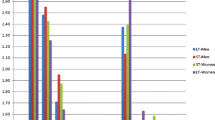Abstract
Little attention has been given to examining the relationship between males' sex roles and their attitudes and behaviors regarding contraceptive issues. The present study addresses this shortcoming by examining the relationships among husbands' sex-role preferences, perceptions of contraceptive responsibility, and hypothetical intentions regarding the possible adoption of a male birth control pill. Data are drawn from a mailed survey of 49 husbands during 1982 in Columbus, Ohio. Egalitarian sex-role preferences are moderately related to a greater stated likelihood of male pill usage for the sample as a whole and more strongly related for husbands not overly concerned with the chemical nature of a male pill. Modern sex-role preferences are also related to husbands' perception of contraception as a shared responsibility, although this perception is not related to the stated likelihood of male pill usage.
Similar content being viewed by others
References
Balswick, J. O. Attitudes of lower class males toward taking a male birth control pill. The Family Coordinator, 1972, 21, 195–199.
Benditt, J. M. Current contraceptive research. Family Planning Perspectives, 1980, 12, 149–155.
Benson, T. Impregnators of teenagers and their part in the pregnancy resolution decision, Doctoral dissertation. Detroit: Wayne State University, 1981.
Blalock, H. Social statistics, 2nd ed. New York: McGraw-Hill, 1979.
Bram, S. Through the looking glass: Voluntary childlessness as a mirror for contemporary changes in the meaning of parenthood. In W. B. Miller & L. F. Newman (Eds.), The first child and family formation. Chapel Hill, N.C.: Carolina Population Center, 1978.
Clark, M. P., & Swicegood, G. Husband or wife? A multivariate analysis of decision making for voluntary sterilization. Journal of Family Issues, 1982, 3, 341–360.
Clark, M. P., Bean, F. D., Swicegood, G., & Ansbacher, R. The decision for male versus female sterilization. The Family Coordinator, 1979, 28, 250–254.
Cooper, P. E., Cumber, B., & Hartner, R. Decision-making patterns and post decision adjustment of childfree husbands and wives. Alternative Lifestyles, 1978, 1, 71–94.
Djessari, C. The politics of contraception. New York: W. W. Norton, 1980.
Djessari, C. Birth control in the year 2001. The Bulletin of the Atomic Scientists, 1981, 37, 24–28.
Fox, G. L. Sex-role attributes as predictors of contraceptive use among unmarried university students. Sex Roles: A Journal of Research, 1977, 3, 265–283.
Gough, H. G. Some factors related to men's stated willingness to use a male contraceptive pill. The Journal of Sex Research, 1979, 15, 27–37.
Goyder, J. C. Further evidence on factors affecting response rates to mailed questionnaires. American Sociological Review, 1982, 47, 550–553.
Heberlein, T. A., & Baumgartner, R. Factors affecting response rates to mailed questionnaires: A quantitative analysis of the published literature. American Sociological Review, 1978, 43, 447–462.
Jaccard, J., Hand, D., Ku, L., Richardson, K., & Abella, R. Attitudes toward male oral contraceptives: implications for models of the relationship between beliefs and attitudes. Journal of Applied Social Psychology, 1981, 11, 181–191.
Luker, K. Talking chances: Abortion and the decision not to contracept. Chicago: University of California Press, 1975.
Misra, B. Correlates of males' attitudes toward family planning. In D. Bogue (Ed.), Sociological contributions to family planning. Chicago: Family and Community Study Center, University of Chicago, 1967.
Mumford, S. D. The vascetomy decision-making process. Studies in Family Planning, 1983, 14, 83–88.
Nieschlag, E., Wickings, E. J., & Breuer, H. Chemical methods for male fertility control: Expert consultation of the European Medical Research Council Adivsory Subgroup on Human Reproduction. Contraception, 1981, 23, 1–10.
Rosen, R. H., & Benson, T. The second-class partner: The male role in family-planning decisions. In G. L. Fox (Ed.), The childbearing decision: Fertility attitudes and behavior. Beverly Hills, Calif.: Sage, 1982, pp. 97–124.
Scanzoni, J., & Szinovacz, M. Family decision-making: A developmental sex role model. Beverly Hills, Calif.: Sage, 1980.
Schearer, B. S. Current efforts to develop male hormonal contraception. Studies in Family Planning, 1978, 9, 229–231.
Shain, R., & Jennings, V. A. The influence of sex roles on fertility. In R. N. Shain & C. J. Pauerstein (Eds.), Fertility control: Biologic and behavioral aspects. Hagerstown, Md.: Harper & Row, 1980, pp. 277–289.
Spillane, W. H., & Ryser, P. E. Male fertility survery: Fertility knowledge, attitudes, and practices of married men. Cambridge, Mass. Ballinger, 1975.
Stokes, B. Men and family planning, Worldwatch Paper 41. Washington, D.C.: Worldwatch Institute, 1980.
Stycos, J. M. A critique of the traditional planned parenthood approach in under-developed areas. In C. V. Kiser (Ed.), Research in family planning. Princeton, N.J.: Princeton University Press, 1952.
Veevers, J. E. Voluntary childless wives: An exploratory study. Sociology and Social Research, 1973, 57, 356–366.
Weinstein, S., & Goebel, G. The relationship between contraceptive sex role stereotyping and attitudes toward male contraception among males. The Journal of Sex Research, 1979, 15, 235–242.
Westoff, C., & Jones, E. F. Patterns of aggregate and individual changes in contraceptive practice: United States, 1965–1975. Hyattsville, Md.: U.S. Department of Health Education and Welfare, 1979.
World Health Organization Task Force on Psychosocial Research in Family Planning. Acceptability of drugs for male fertility regulation: A prospectus and some preliminary data. Contraception, 1980, 21, 121–134.
World Health Organization Task Force on Psychosocial Research in Family Planning. Hormonal contraception for men: Acceptability and effects on sexuality. Studies in Family Planning, 1982, 13, 328–342.
Author information
Authors and Affiliations
Additional information
A preliminary version of this paper was presented at the North Central Sociological Association meeting in Columbus, Ohio, April 1983. I would like to thank Elizabeth G. Menaghan and Clyde W. Franklin, II, for their helpful critiques of early drafts of this paper. I am also indebted to an anonymous reviewer for his/her critical comments.
Rights and permissions
About this article
Cite this article
Marsiglio, W. Husbands' sex-role preferences and contraceptive intentions: The case of the male pill. Sex Roles 12, 655–663 (1985). https://doi.org/10.1007/BF00288184
Issue Date:
DOI: https://doi.org/10.1007/BF00288184




